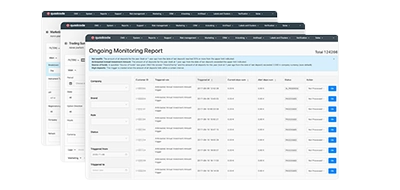Back
Contents
Что такое скользящая средняя?

Demetris Makrides
Senior Business Development Manager

Iva Kalatozishvili
Business Development Manager
Скользящие средние — это статистический инструмент и индикатор, используемый финансовыми аналитиками для расчета средней цены актива за определенный период времени с целью нормализации ценовых данных и выявления закономерностей на более длительных временных интервалах. Этот подход усредняет данные за определенный период времени для получения актуальной цены актива, например, акции или товара. Скользящие средние помогают трейдерам и инвесторам оценить долгосрочную перспективу и отфильтровать временный рыночный шум. В данной статье рассматриваются скользящие средние, их многочисленные формы, области применения и торговые приложения.
Типы скользящих средних
Существует несколько видов скользящих средних, каждый из которых служит определённым целям и позволяет лучше понять поведение рынка. Среди используемых типов — простая скользящая средняя и экспоненциальная скользящая средняя. Агрегирование ряда чисел за заданное количество периодов создаёт простую скользящую среднюю (SMA), или простая скользящая средняя. To get the 10-day простая скользящая средняя, add the closing values of the past 10 days then divide the total by 10. This approach assigns equal weight to every data element, therefore simplifying the identification of trends. Экспоненциальная скользящая средняя Экспоненциальная скользящая средняя (EMA) придаёт последним данным больший вес, чем простая скользящая средняя (SMA). Это помогает EMA быстрее усваивать новые данные, тем самым повышая её способность выявлять краткосрочные ценовые колебания и одновременно сглаживать колебания. Когда ценовые колебания происходят внезапно, как это обычно бывает на волатильных рынках, экспоненциальная скользящая средняя очень полезна.
Другие формы скользящей средней, такие как скользящая средняя Халла (HMA) и взвешенная скользящая средняя (WMA), которые устраняют задержку или присваивают больший вес более свежим данным, тем самым обеспечивая еще большую гибкость для продвинутых трейдеров.
О чем сигнализирует скользящая средняя?
Скользящая средняя — это скользящий индикатор, то есть он опирается на цены и выявляет уже сформировавшиеся тренды. Тем не менее, именно это свойство делает скользящие средние эффективными для определения направления рынка. Если цена актива постоянно превышает скользящую среднюю, считается, что она находится в восходящем тренде. Обычно нисходящий тренд наблюдается, когда цены опускаются ниже скользящей средней.
Скользящие средние также могут указывать на уровни поддержки и сопротивления. Например, на бычьем рынке долгосрочная скользящая средняя может служить поддержкой, поскольку цены часто отскакивают от неё во время откатов. Однако на нисходящем рынке скользящая средняя может предотвратить слишком сильный рост цен.
Если, например, 50-дневная простая скользящая средняя пересекает 200-дневную, рынок готов к изменению. Для некоторых трейдеров это пересечение является важным сигналом, указывающим либо на начало тренда, либо на необходимость продажи текущей позиции.
Одна из ключевых функций — определение тренда. Трейдеры могут использовать скользящие средние, чтобы лучше понять, движется ли рынок вверх, вниз или в горизонтальной плоскости, поскольку они сглаживают колебания цен.
В контексте управления рисками скользящие средние являются важнейшим инструментом. Трейдеры могут оценить волатильность рынка, анализируя степень отклонения цены от скользящей средней. Трейдеры могут корректировать настройки стоп-лоссов или позиции в соответствии с данными, полученными по итогам анализа. Этот метод позволяет трейдерам сохранять дисциплину в торговле, что, в свою очередь, снижает вероятность принятия решений в условиях меняющейся рыночной ситуации.
Что такое MACD?
Схождение-расхождение скользящих средних (MACD) — технический индикатор, часто используемый на финансовых рынках. Он показывает изменение ценового тренда, силы и импульса акции. Для эффективной работы он сравнивает две скользящие средние цены, обычно 12-дневную и 26-дневную экспоненциальные скользящие средние (EMA). После этого для отслеживания расхождения между двумя средними используется линия MACD. Эта линия получается путём вычитания 26-дневной EMA из 12-дневной EMA.
Линия MACD, иногда называемая сигнальной линией, представляет собой экспоненциальную скользящую среднюю, охватывающую девять дней. Обычно это рассматривается как сигнал к покупке, поскольку пересечение линии MACD сигнальной линии сверху вниз указывает на усиление восходящего импульса. С другой стороны, когда линия MACD опускается ниже сигнальной линии, что указывает на усиление нисходящего импульса, это может быть потенциальной точкой продажи.
Дополнительным элементом MACD является гистограмма, которая визуально показывает расстояние между линией MACD и сигнальной линией. Трейдеры могут использовать эту гистограмму для быстрой оценки силы импульса. Увеличение высоты столбцов гистограммы указывает на увеличивающийся разрыв между линией MACD и сигнальной линией. В результате создается впечатление, что тенденция набирает обороты и расширяется. Уменьшение размера столбцов указывает на то, что импульс теряет часть своего преимущества.
Для трейдеров, работающих на рынках, где в данный момент наблюдается тренд, индикатор MACD становится особенно полезным, поскольку он помогает оценить силу тренда и выявить возможные области разворота. Анализ взаимодействия линии MACD, сигнальной линии и гистограммы помогает соотносить торговые стратегии с текущей рыночной динамикой. Это позволяет розничным торговцам, обладая более глубокими знаниями, принимать решение о совершении сделки или отказаться от неё.
Что такое Золотой Крест?
Фигура «золотой крест» на графике формируется, когда краткосрочная скользящая средняя превышает долгосрочную. Когда 50-дневная простая скользящая средняя пересекает 200-дневную простую скользящую среднюю, формируется «золотой крест». Эта фигура обычно воспринимается как признак возможного восходящего тренда.
Золотой крест обычно подтверждает смену рыночных настроений с медвежьих на бычьи. Участники рынка могут использовать эту модель для открытия новых позиций или укрепления уже существующих. Смертельный крест, напротив, представляет собой противоположность, когда краткосрочная скользящая средняя опускается ниже долгосрочной, что указывает на медвежьи настроения.
Использование скользящих средних
Использование скользящих средних требует понимания контекста их применения. Трейдеры часто объединяют скользящие средние с индикаторами, чтобы расширить свой анализ и повысить точность торговых сигналов.
Осциллятор, такой как RSI, может использоваться трейдером для определения перекупленности или перепроданности рынка. Например, скользящую среднюю можно использовать для определения направления тренда. Используя этот метод, трейдер может сосредоточиться на возможностях с высокой вероятностью выигрыша и игнорировать сигналы.
Другая распространённая практика — использование скользящих средних в качестве уровней поддержки и сопротивления. Когда цена приближается к скользящей средней, трейдеры могут отслеживать признаки отскока или пробоя, используя эти уровни для определения точек входа или выхода.
Скользящие средние также используются вместе с ценовыми паттернами. Например, скользящая средняя может подтвердить прорыв графической фигуры, такой как треугольник или «голова и плечи», повышая уверенность трейдеров в своих сделках.
Важность метода скользящей средней
Использование скользящей средней играет важную роль как в техническом анализе, так и в управлении рисками. Отражая направление рынка, скользящие средние помогают трейдерам следовать преобладающему тренду, минимизируя желание торговать против тренда, что может быть более рискованно.
Кроме того, скользящие средние служат инструментами, которые могут подходить различным стилям торговли, будь то краткосрочная дневная торговля или долгосрочное инвестирование.
Трейдеры могут выбирать различные периоды, например, 10, 50 или 200 дней, чтобы настроить скользящую среднюю в соответствии со своими торговыми предпочтениями. Эта гибкость позволяет им адаптировать стратегию скользящей средней к своим потребностям, независимо от того, стремятся ли они к быстрым импульсным сделкам или к выявлению долгосрочных трендов.
Использование скользящих средних может быть полезным для всех трейдеров, независимо от уровня подготовки, поскольку они упрощают анализ ценовых данных. Изучение того, как использовать скользящие средние в своей торговле, может быть полезно даже новичкам.
Примеры скользящей средней
Рассмотрим пример, демонстрирующий работу скользящих средних. Представьте себе акцию, которая стабильно растёт в течение нескольких месяцев. Трейдер решает применить 50-дневную простую скользящую среднюю (SMA) к графику цены акций. Постоянный рост линии SMA чётко указывает на восходящий тренд. Когда происходит откат рынка, и цена акций касается 50-дневной SMA, прежде чем резко отскочить вверх, этот отскок от скользящей средней служит подтверждением силы тренда. В ответ трейдер может рассмотреть возможность открытия или увеличения позиции.
Другой вариант — использовать 200-дневную экспоненциальную скользящую среднюю для оценки валютной пары на рынке. Цена меняет направление с медвежьего на бычье при пробитии 200-дневной экспоненциальной скользящей средней. Трейдер может рассматривать это пересечение как возможность заработать на ожидаемом подъёме и перейти от коротких продаж к длинным покупкам.
Классы активов и MA
Все классы активов, включая акции, криптовалюты, валюту, сырьевые товары и т. д., могут получить значительную выгоду от использования скользящих средних в качестве индикаторов. Однако скользящие средние действуют по-разному в зависимости от класса активов. Обычно основным определяющим фактором является рассматриваемый актив.
Применительно к акциям скользящие средние (MA) обычно используются для определения долгосрочных трендов и определения точек входа и выхода для сделок. Поскольку акции относительно стабильны и не подвержены резким колебаниям, как криптовалюты, скользящие средние, такие как 50-дневная и 200-дневная простые скользящие средние (SMA), надёжны для определения направления тренда. Таким образом, если акция в течение некоторого времени на бычьем рынке торгуется выше 200-дневной SMA, это считается сильным сигналом к покупке. Аналогично, если цена пересекает эту среднюю, это является явным признаком смены тренда и разворота.
Скользящие средние (СМА) ведут себя на рынке Форекс по-разному, поскольку он работает круглосуточно. Кроме того, на рынок сильное влияние оказывают глобальные экономические факторы. В результате валютные пары могут резко реагировать и совершать резкие колебания в ответ на изменения процентных ставок, различные геополитические события и явления, а также публикацию экономических данных. Учитывая это, трейдеры обычно используют 20-дневную и 50-дневную экспоненциальные скользящие средние (EMA) – краткосрочные скользящие средние, – чтобы попытаться выявить изменения импульса и трендов, которые могут быстро произойти на рынке Форекс.
При торговле различными товарами, такими как золото и серебро, использование скользящих средних (MA) представляет собой совершенно иную задачу и требует особых условий. Товарные рынки часто подвержены сильному влиянию внешних факторов. К ним относятся динамика спроса и предложения, погодные условия и, конечно же, геополитическая напряжённость и новости. Поскольку рынок быстро меняется и подвержен изменениям, настройки скользящих средних необходимо корректировать соответствующим образом, быстро и часто в ответ на эти внешние факторы. Как и в торговле на Форекс, краткосрочные скользящие средние (MA) — это оптимальный способ быстро адаптироваться к рыночным условиям.
Возможно, самым сложным рынком для применения индикаторов скользящих средних является криптовалютный рынок. Поскольку криптовалюты — новый и очень волатильный класс активов, быстрые ценовые колебания и рыночные манипуляции могут привести к рыночным «перекосам», когда цены многократно взлетают и падают, проходя через скользящие средние за короткий промежуток времени. В результате традиционные скользящие средние становятся гораздо менее надежными. Для использования скользящих средних на криптовалютном рынке трейдеры обычно комбинируют различные индикаторы скользящих средних, включая скользящую среднюю Халла, а также используют различные таймфреймы, чтобы получить более стабильный сигнал.
Заключение
Скользящая средняя служит инструментом анализа, предлагая трейдерам и инвесторам надежный метод выявления трендов, генерации торговых сигналов и управления рисками. Сглаживая ценовые данные и фильтруя рыночный шум, скользящие средние дают представление о направлении и динамике рынка. Независимо от того, используются ли они отдельно или в сочетании с индикаторами, скользящие средние являются инструментами, способными повысить эффективность любой торговой стратегии. Понимание и применение скользящих средних в рыночных условиях позволяет трейдерам принимать решения, ведущие к более успешной и дисциплинированной торговле. В качестве инструмента анализа скользящая средняя остается бесценным инструментом для тех, кто ориентируется в сложных условиях финансовых рынков.
Обновлено:
19 декабря 2024 г.




